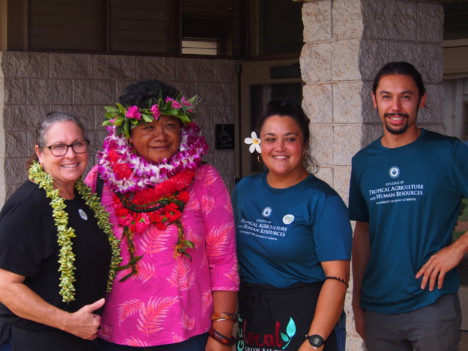Farmer Focus Amid Shipping Rate Concerns
Young Brothers, the only interisland shipping company in the state, is proposing a substantial rate increase starting summer 2025.
If passed by the state Public Utilities Commission, shipping costs would increase an average of 20 percent, with pallet cargo rates soaring to 30 percent for dry cargo and 40 percent for refrigerated.
Molokai farmers are already at a disadvantage when selling products off-island because of this “extra-leg” shipping cost from Molokai to bigger markets, explained Jennifer Hawkins, UH College of Tropical Agriculture and Human Resources (CTAHR) extension agent for Molokai.
Eyeing that farming landscape, longtime Molokai farmer Bobby Alcain explained that he’s concerned about the health of Molokai agriculture.
“On a scale of one to 10, we’re at about a four,” explained Alcain, who focuses on sustainable farming on his five-acre farm.
Alcain likewise explained that the shipping costs needed to get Molokai products to market severely hinder the ability for farming at a commercially successful level.
“It’s a double-whammy,” he said. “We have to grow it, package and ship it [in and out].”
But Hawkins and Molokai farmers aren’t ringing alarm bells just yet.
While the norm for Molokai farms has historically been bigger 10-to-40-acre farms focused on larger scale commercial products, according to Hawkins, there has been a recent shift to smaller, one acre or less, “subsistence gardens,” as she calls them.
Post COVID pandemic, lots of these small farms popped up with the goal of selling fresh produce to local markets, rather than developing commercial scale crops for sale off-island.
“Demographics have changed,” said Hawkins. In response, the agricultural support systems like the Dept. of Ag and UH “are focusing on smaller, beginner farmers as well.”
“It’s just something that we’ve got to wait and see,” she explained. “One thing about Molokai farmers is that we’re really good at taking what we have and doing something with it.”
In fact, the additional shipping costs could act almost like a protective tariff for certain Molokai markets, allowing these small-scale produce farmers to take advantage of increased costs for off-island products.
“I’m very hopeful that we’ll look internally for more and more of that produce,” Hawkins explained. “There has been a big consumer push to look for local and not shipped goods…so the local agriculture economy can handle a little bit of growth.”
This year, Molokai farmers received some additional assistance in the form of the first ever Molokai-hosted Farmers Resource Fair. Over 50 Molokai farmers and eight University of Hawaii extension agents along with Dept. of Agriculture and various UH and Maui County programs made their way to the Mitchell Pauole Center for the Oct. 25 fair.
“What we want to do is bring together resource providers,” explained Hawkins. The event is a chance for farmers and resource providers to talk face to face for advice on grants and loan programs, as well as plant diseases, pest control and more.
“This is specifically a farmers’ event,” she said, geared towards Molokai’s current and future agricultural landscape. Events like the Farmer Resource Fair help to prepare farmers for future challenges, as well as expand cooperation between sectors like farming and small business entrepreneurs.
Held for the first time on Molokai, the resource fair also celebrated a special recognition for Faith Tuipulotu, the agricultural technician for UH CTAHR Molokai, for her 20 plus years of work.
While farming on Molokai may have additional hurdles, for those immersed in their craft, the rewards are worth it.
“I do it because I like to eat,” said Alcain, grinning.












Don't have a Molokai Dispatch ID?
Sign up is easy. Sign up now
You must login to post a comment.
Lost Password